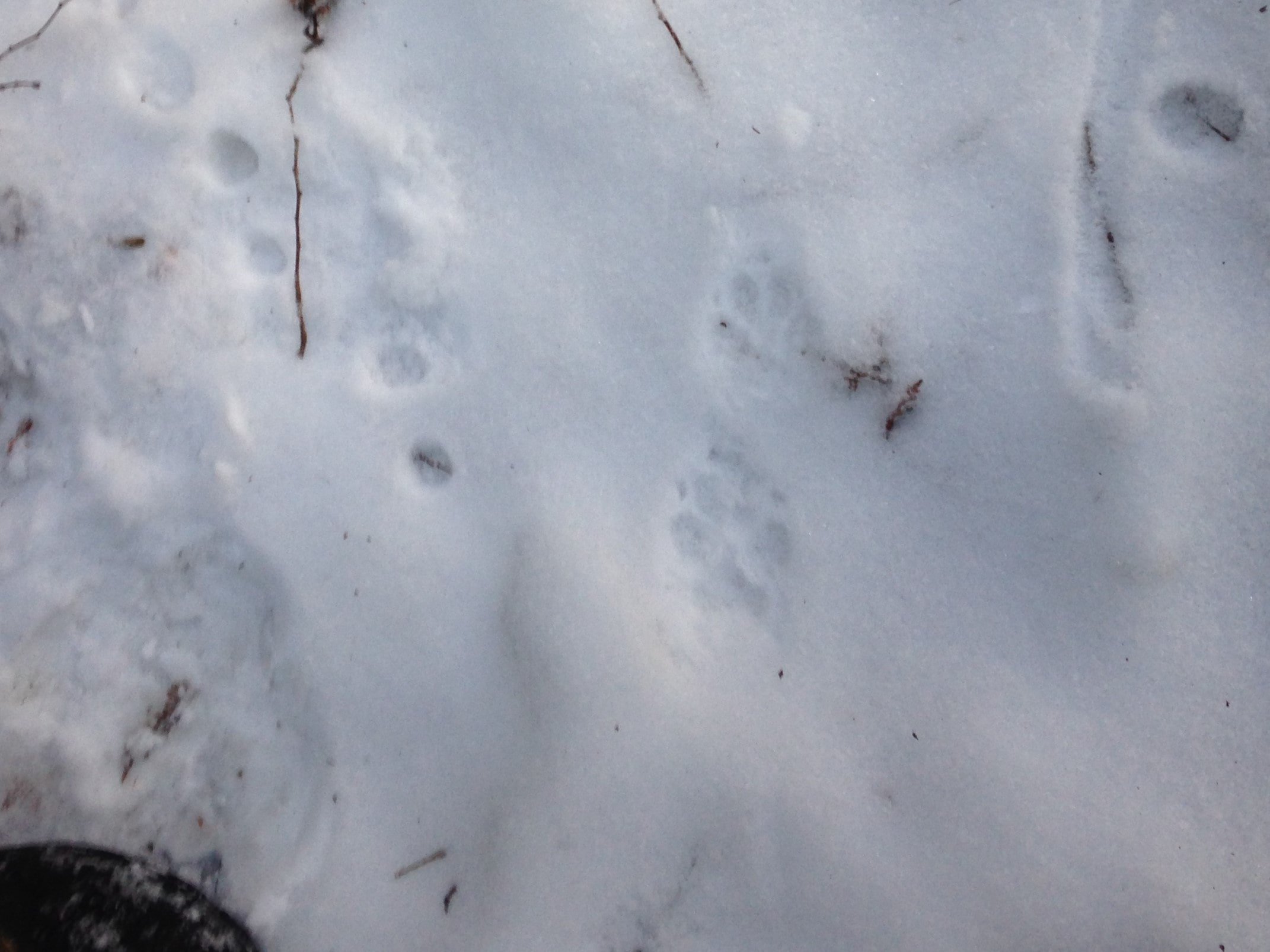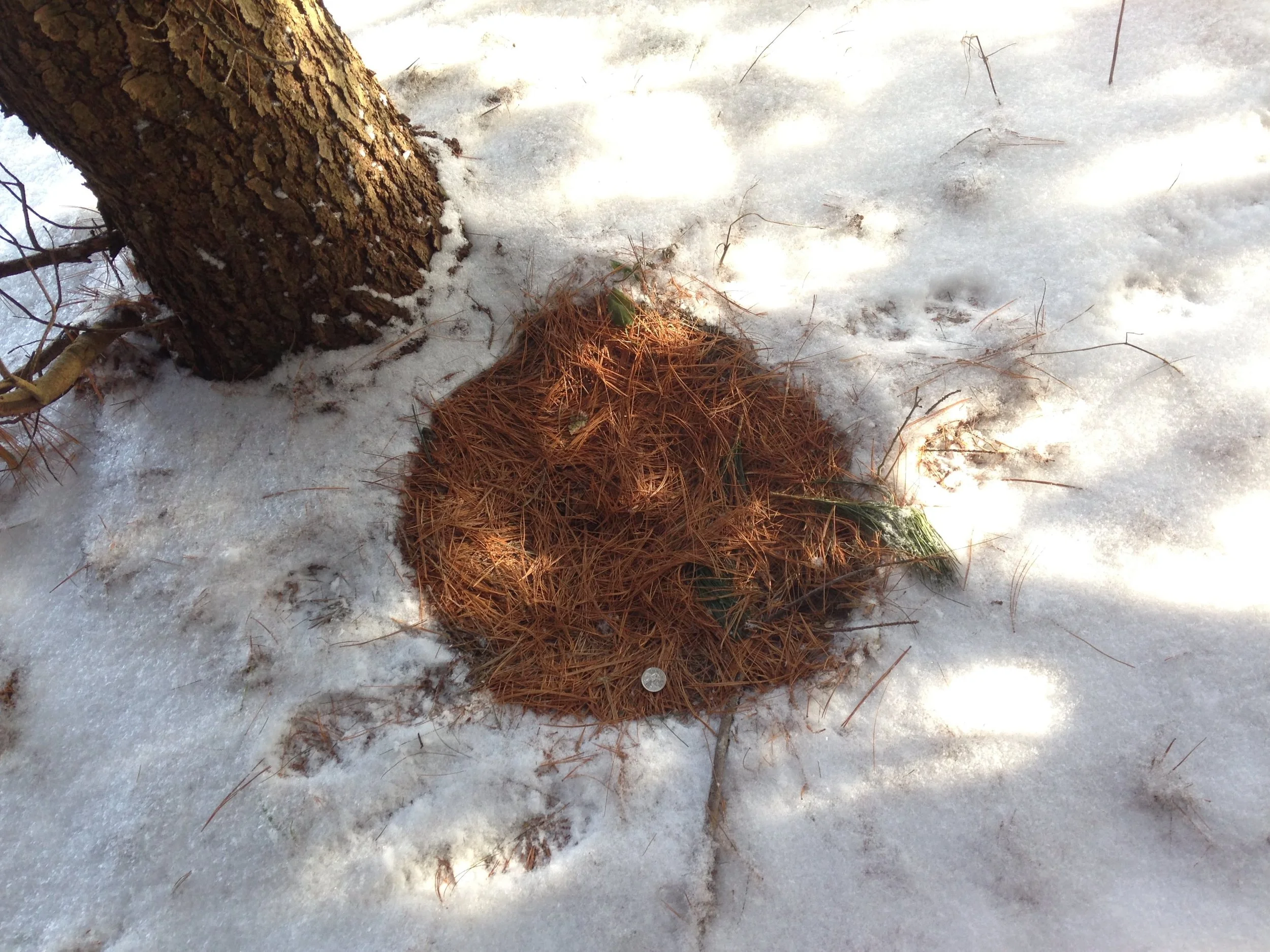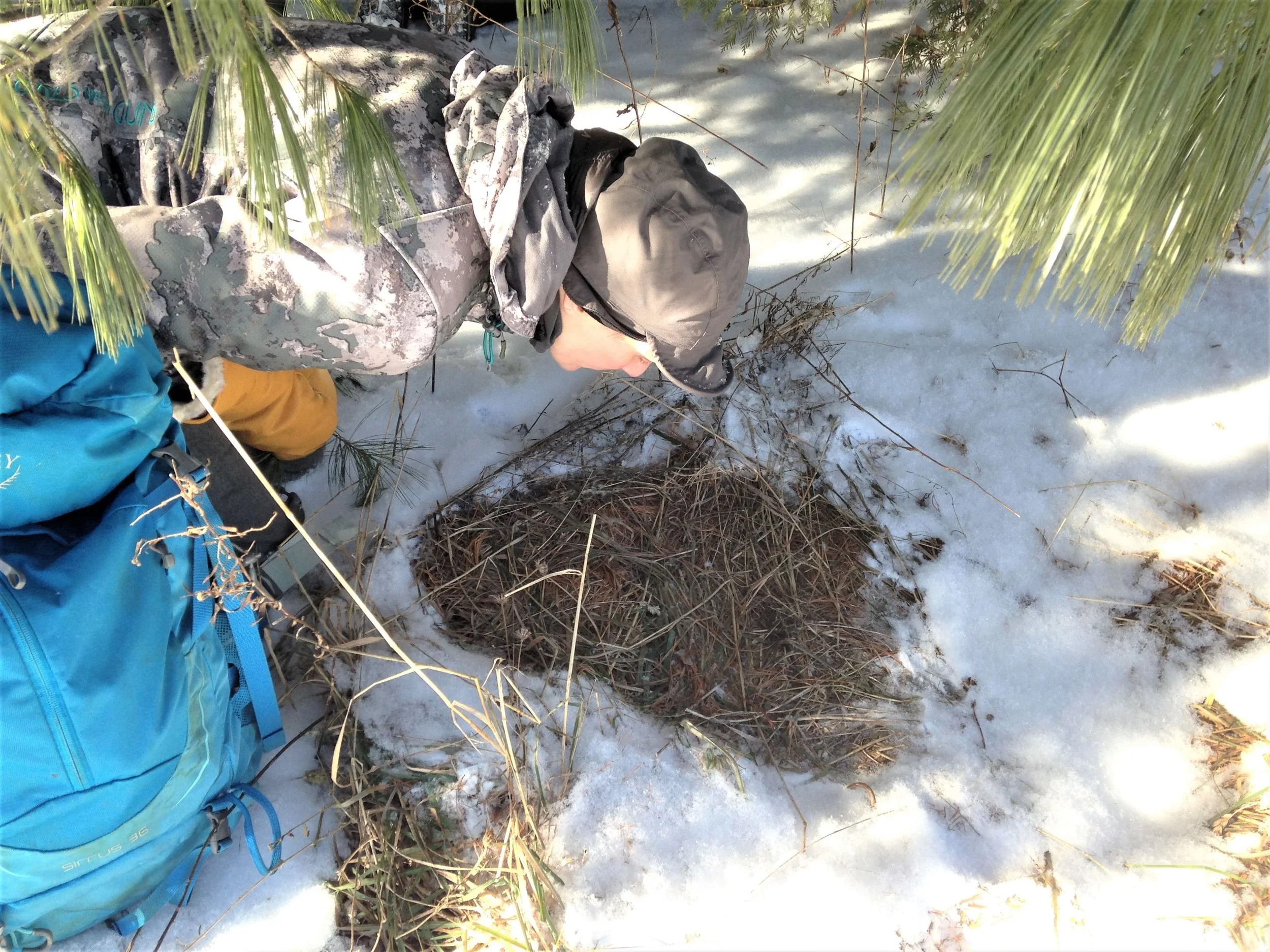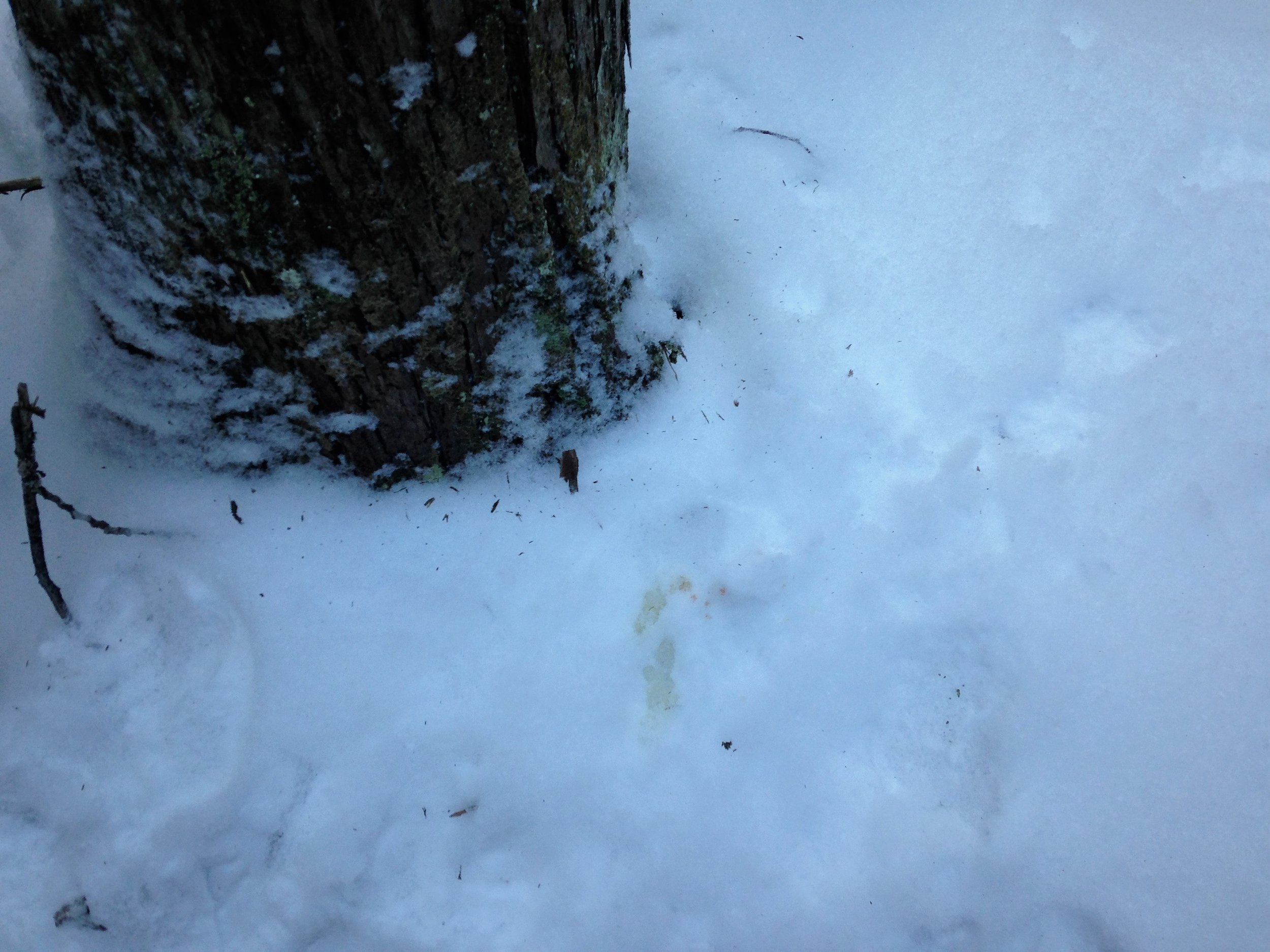Examining Coyote Courting Behaviours : Tracking at Bell’s Lake
On Saturday we met up at Bell’s Lake Management Area in West Grey County to go tracking with the apprenticeship crew. Marcus and I pulled up I noted the trail along the middle of the road, between the tire tracks, where it looked like some sort of canid had been walking along. The folks who were already there had already noticed this trail and were exploring other trails as well. As everyone arrived we circled up and then decided to follow the trail into the woods and see what else we could figure out.
We had to check out the trail and the size of the tracks a couple of times before we could really confirm that this was an Eastern Coyote (Canis latrans) that we were following. The way we confirmed this was to measure the individual feet, and the stride length of the gaits. I have to be honest and say that I cannot remember the stride or trail width measurements, as I did not write them out, but I remember checking the foot measurements with the numbers from Mark Elbroch’s Mammal Tracks and Sign. He notes that Coyote’s front tracks measure between 6.7 - 8.9 cm (2⅝ - 3½ in) L x 4.1 - 7.3 cm (1⅝ - 2⅞ in) W and the hinds come in around 6 - 8.3 cm (2⅜ - 3¼ in) L x 4.1 - 6 cm (1⅝ - 2⅜ in) W, while Red Foxes’ (Vulpes vulpes) measure between 4.8 - 7.3 cm (1⅞ - 2⅞ in) L x 3.5 - 5.4 cm (1⅜ - 2⅛ in) W and hind tracks will measure between 4.1 – 6.4 cm (1⅝ - 2½ in) L x 3.2 – 4.8 cm (1¼ - 1⅞ in) W. The front right foot was 6.5 cm L x 5 cm W, and the right hind was 6.3 cm L x 4.3 cm W, which could have landed on the larger end of the Red Fox, but then we noticed something else…There was another Coyote trail. This other trail had slightly longer strides, and definitely bigger feet (right front: 8.3 cm L x 6 cm W, and the right hind 6.7 L x 5.5 W). Not only was it cool to confirm Coyote, but this other sign added another layer of reasoning to the idea that not only was this two Coyotes, but possibly a larger male alongside a smaller female. This started to give us some ideas of what could be happening between these two.
Both the males and the females participate in courting behaviours during a physiological period known as proestrus, where the uterus enlarges and the vaginal canal distends. This proestrus period is similar in traits to domestic Dogs (Canis lupus familiaris), in that this is when the vulva starts to swell and the blood or “sanguinous fluids” begin to be seen in the females urine. Male Coyotes are attracted to the females, but the females are not receptive during this period. The proestrus period begins for Coyotes around mid-December. Some courting behaviours can include:
playful wrestling and chases
scent marking together, which includes scrapes and males urinating atop the females urine or scat deposits
grooming each other
body bumps and hip pushes (“love shoves” as I call them)
sleeping curled up together
males sniffing or licking the females genitals
After the proestrus phase, the estrus period begins. This period only lasts for about 2-5 days and is marked by females being receptive to males and mating behaviours such as mounting and intercourse. After intercourse, the scent marking routine switches, with the males urinating first, followed by the females marking atop their deposits. Of course this wasn’t all happening in the tracks in front of us, but we started wondering aloud.
Just a short ways in along the trail we came across another beautiful sign. A scuffed up area where the snow had been scratched up into small narrow piles in the center. It was a scrape. Scrapes and other forms of scent marking are a big part of this proestrus period typified by courting behaviours. If we had missed the scrape, only a few meters from the road, I don’t think I would’ve felt as certain that they were courting, but the scrape in the snow really cemented it for me.
I had trailed a pair before on Christmas Day, 2020, and seen similar behaviours. What I saw at Bells Lake echoed what I had seen in 2020. It looked like the female had come along and scraped by a tree. Then the male came up afterwards and scraped atop of the females scrape. I have read that this behaviour often also includes urination by both female and the male before they each scrape, which I have seen before with Eastern Wolves (Canis lycaon) in Algonquin Park where a male was following a female and everywhere she scent marked, he did as well. While I could not detect any urine or scat in this particular Coyote scrape, mating Coyote pairs will scent mark in tandem as estrus approaches.
One website I was checking out mentions that not only do Coyote feet have glands which deposit scent, the act of scraping may help scatter and spread the scent of urine. The author also wonders, and I think this could make sense, if the Coyote steps in their urine, could the scent then be carried and deposited as the Coyote moves across the landscape, transferred to the ground from the pads and fur on their feet? Seems to make sense to me. In another paper I was checking out the researchers in Wyoming noted that ground scrapes were most common during the period of late-December to early-February, in what I would consider early to middle of the mating season, when mating pair bonds are being strengthened and reinforced. This scraping/double-scraping behaviour seems to be an essential part of the Coyote courting repertoire.
We followed the Coyotes for a while, encountering a smaller Shrew (Sorex spp.), Snowshoe Hare (Lepus americanus), Red Squirrel (Tamiasciurus hudsonicus) trails along the way. I remember there were times when the larger Coyote, again, likely a male, moved in direct register trot, the other Coyote, the female, moved in a side trot. The side trot is a faster gait than the slower direct register trot. This can be shown by the presence of the track of the hind foot landing ahead and to the side of the track of the front foot. With the hinds to the sides of the fronts, this allows them to travel a bit faster than the direct register trot without their feet hitting as they move.
It was interesting to note the habits of the Coyotes as they moved over the forested landscape. The two individuals would weave their way together and apart, together and then apart, their trails entwining and braiding across the snowy forest floor. The front feet would betray head turns when the Coyotes would look off into the forest behind them, perhaps looking for the other Coyote, or when they would look off to the side, perhaps picking up a distant scent on the wind. At one point the two took different trails, with the smaller female crossing the ice over a frozen pond, while the larger male went around the pond. Perhaps this was just chance, but I think it had more to do with the male understanding his own weight and the capacity of the ice to hold him or not.
Female Coyote tracks crossing the frozen pond
I can’t remember who saw it first, it definitely wasn’t me, but while I was face down in the snow measuring the female’s tracks in an overstep walk, up ahead of me everyone was at the edge of the forest admiring a snowless patch of White Pine (Pinus strobus) needles at the edge of a sunny field. The patch was nearly round and measured about 44 cm (17⅜ in) in diameter. On the other side of the Pine, others were investigating another patch free of snow, this time grassy, and more kidney bean shaped than circular. This second patch measured 57 cm x 44 cm (22½ in x 17⅜ in). These were Coyote beds! I have seen other canid beds including Eastern Wolf and Red Fox, but never Coyotes. This was an awesome find. It was already an exciting trailing experience but it just kept getting better. My first thought was that the larger bed belonged to the male, but the folks at that bed checked the track sizes and noted that it was in fact the female who had the larger bed, and the male who had the smaller, rounder bed. Someone had mentioned that the bed could be smaller as the male curled up tighter to stay warmer as they were positioned more in the forest, in the shade of the Pine, while the female was positioned closer to the field, in what could have been lots of sun. In the second edition of Mammal Tracks and Sign by Mark Elbroch and Casey McFarland, they write that Coyotes may choose bedding sites with a view of their surroundings, and places where “scents and sounds may carry. Otherwise they bed in thickets or other cover that provide protection”. These beds seemed to be the more awareness enhanced rather than protection enhanced. Curious if this is due to the lack of common predators in this part of the world? If there were more Wolves or Cougars (Puma concolor), would the Coyotes have different bedding strategies?
44 cm (17⅜ in) in diameter
57 cm long x 44 cm tall (22½ in x 17⅜ in)
In the paper “Reproductive Biology of the Coyote (Canis latrans): Integration of Mating Behavior, Reproductive Hormones, and Vaginal Cytology” by Eric Gese there is mention of Coyotes “sleeping curled against each other” but no mention of bedding adjacent to each other. I wonder if this sleeping separately is indicative of the the pair not demonstrating breeding behaviours, but instead, are still courting. I wonder if the beds slowly get closer as the breeding season gets closer and the female tolerates more intimate advances from the male?
Image of an overstep walk, a pretty chill gait
After the beds the Coyotes made their way across another small squishy wetland area, under some Cedars (Thuja occidentalis) and into and across a couple snowy fields. Another gait we noticed as the Coyotes were making their way across the field was an overstep walk, which is characterized by the hind foot landing ahead of the track of the front foot from the same side of the body. This is a more-chill pace than the side trot mentioned above, but still a bit faster than a walk as the hind feet are landing further ahead than the fronts did. The pattern of the footfall in the image to the right is, starting from the track closest to the camera, left front with the left hind landing slightly ahead, followed by the right front and then the right hind. This pattern of footfall, the width of the trail and the lack of significant breaks or spaces in the rhythm of the footfall all indicate a relaxed gait. The other Coyotes trail was just to the right of this one, less than a meter away.
A note to keep in mind when analyzing gaits is that, usually, the further ahead the hind feet are on the trail, the faster the animal is going. Here is a short video discussing three common Wolf gaits, which Coyotes also share.
We followed through the Cedars on the far edge of the field, sat down for lunch, and enjoyed the warmth of the Sun. When the group got up, I fell behind again to take a couple more measurements and only caught up when folks had found another great discovery.
In the shade of the Cedar grove, the Coyote trails led up to the base of a tree. There set on the snow like a ray of sunshine was a small spot of urine dotted with blood. This is the gift of the season, full of possibility and potentially translating to the future offspring of these two Coyotes.
In one paper I read this bloody discharge can begin in early December, which would correlate with with what we saw on January 14th. Males are very aware of the females during this period and appear to be ready to go, but the females won’t allow the males to mount. While this blood (or “sanguinous fluids” as the researchers sometimes call it) is very exciting, it is worth noting that it is only a small amount, and none was noticed in the bed, along the long snowy trail, or in the scrapes seen at the start of the day. This coulld indicate that the estrus period has not yet come into full swing and we were still observing signs of the proestrus courting behaviours. Remember, Coyotes are monoestrus, meaning they come into heat only once a year, usually for about a 10 day period. This mating period is preceded by a proestrus period, which is when the courting behaviour occurs. This courting period can last up to two months, and this I believe is what we were witnessing along these two trails.
Getting the chance to follow along and watch the intimate lives of other animals can feel a little awkward in the retelling. I don’t want to come across as voyeuristic but instead as being witness to the possibility of a litter of new life. Coyotes are often a maligned species, where the conversation surrounding them is often of management and control, loaded with tones of fear and frustration. But following these two highlights an individuation and animism we don’t afford Coyotes very often. I hope only to remind of the struggle to survive, adapt and thrive amidst the persecution they endure. Reflecting on the day, I feel like it’s a study in the mess of courtship which many of us can relate to, and it feels like the news I wish we saw more of: first kisses, late night dinner parties with old friends, meeting a newborn family member. It is the joy of being and relating to others in deep meaningful ways in a world which often separates and isolates, harms and hinders. It’s romantic as hell, and I love it. I am inspired by this trailing adventure and am eager for more. Deep gratitude for these two Coyotes and for the crew I got to track them with. Thank you thank you thank you.
To learn more :
Mammal Tracks and Sign by Mark Elbroch. Stackpole Books, 2001.
Behaviour of North American Mammals by Mark Elbroch and Kurt Rinehart. Houghton Mifflin Harcourt, 2011.
Tracking Journal from Dec 25, 2020
Precopulatory and Copulatory Behavior in Coyotes by Marc Bekoff, Judy Diamond
The Estrous Cycle of Coyotes by J.J. Kennelly and B.E. Johns
Reproductive Biology of the Coyote (Canis latrans): Integration of Mating Behavior, Reproductive Hormones, and Vaginal Cytology by Eric Gese
Breeding Season: Wandering, Sniffing, Marking and Scraping from CoyoteYipps.com
An Observational Study of Scent-Marking in Coyotes, Canis latrans







